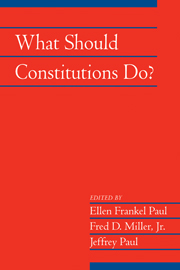Book contents
- Frontmatter
- Contents
- Introduction
- Acknowledgments
- Contributors
- What Are Constitutions, and What Should (and Can) They Do?
- Constitution and Fundamental Law: The Lesson of Classical Athens
- Contract, Covenant, Constitution
- Constitutionalism in the Age of Terror
- The Liberal Constitution and Foreign Affairs
- Do Constitutions Have a Point? Reflections on “Parchment Barriers” and Preambles
- The Origins of an Independent Judiciary in New York, 1621-1777
- Foot Voting, Political Ignorance, and Constitutional Design
- Pluralist Constitutionalism
- Deliberative Democracy and Constitutions
- The Constitution of Nondomination
- Can We Design an Optimal Constitution? Of Structural Ambiguity and Rights Clarity
- Index
Constitutionalism in the Age of Terror
Published online by Cambridge University Press: 05 June 2012
- Frontmatter
- Contents
- Introduction
- Acknowledgments
- Contributors
- What Are Constitutions, and What Should (and Can) They Do?
- Constitution and Fundamental Law: The Lesson of Classical Athens
- Contract, Covenant, Constitution
- Constitutionalism in the Age of Terror
- The Liberal Constitution and Foreign Affairs
- Do Constitutions Have a Point? Reflections on “Parchment Barriers” and Preambles
- The Origins of an Independent Judiciary in New York, 1621-1777
- Foot Voting, Political Ignorance, and Constitutional Design
- Pluralist Constitutionalism
- Deliberative Democracy and Constitutions
- The Constitution of Nondomination
- Can We Design an Optimal Constitution? Of Structural Ambiguity and Rights Clarity
- Index
Summary
INTRODUCTION
What should constitutions do? To answer this question, we must begin with a prior one: What is a constitution? The idea of a constitution is very old, roughly as old as systematic thinking about politics. It was a central idea in the thinking of the Greeks, the first systematic political scientists. But if we go to Plato or Aristotle expecting to find the concept of constitution we deploy when we speak of “constitution,” we will be surprised and perhaps disappointed. They use the term in the primordial sense of the word that we still readily recognize when we speak of someone as having a strong constitution. “Constitution,” as used here and by the older political writers, means primarily the makeup of something–in the political case, the structure and arrangement of political offices. In the first instance, “constitution” was a descriptive term, but the Greeks also regularly asked: What is the best constitution?–a variant of the question we are asking, “What should constitutions do?”
In the United States and many other places, our usage of the term “constitution” does indeed still contain some of this earlier meaning, for when we think of the Constitution we also think of the layout of the offices of governance. But we think of other things as well. In particular, the Constitution for us is a document, a written legal text, able to be adjudicated in court.
- Type
- Chapter
- Information
- What Should Constitutions Do? , pp. 72 - 114Publisher: Cambridge University PressPrint publication year: 2011
- 1
- Cited by



